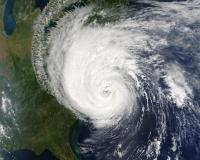
Vibrant Environment
Governance And Rule Of Law
All | Biodiversity | Climate Change and Sustainability | Environmental Justice | Governance and Rule of Law | Land Use and Natural Resources | Oceans and Coasts | Pollution Control

In 2017, almost eight percent of the American population was affected by natural disasters. Hurricanes Harvey, Irma, and Maria swept through Florida, Georgia, Texas, Puerto Rico, and the U.S. Virgin Islands, leading to billions of dollars of federal disaster assistance. The 2018 hurricane season was another year of devastating destruction, most recently seen in the aftermath of Hurricanes Florence and Michael in the Southeast, severely affecting the citizens of Alabama, Florida, Georgia, North Carolina, South Carolina, and Virginia. With climate change likely to amplify the impacts of hurricanes, hurricane season will continue to strain communities, infrastructure, and federal disaster programs into the future.

“It’s all happening,” declared a June 2018 article about offshore wind development in the United States. Indeed, the National Renewable Energy Laboratory has identified a trend toward a viable U.S. offshore wind industry that is gaining momentum. Despite this trend, it has been 17 years since the first offshore wind project was proposed, and the 30-megawatt (MW) Block Island Wind Farm is still the only operating project. Has the time finally arrived for this industry?

The United States’ decision to withdraw from the Paris Agreement was a shock to environmentalists and the international community. In response, individual U.S. states took it upon themselves to pledge their commitment to the Paris Agreement without federal support. However, some scholars observed that state involvement in the Paris Agreement may be unconstitutional, a potential violation of the Supremacy Clause, Treaty Clause, and Compact Clause.
In An American (State) in Paris: The Constitutionality of U.S. States’ Commitments to the Paris Agreement, the winner of ELI’s 2017-2018 Henry L. Diamond Constitutional Environmental Law Writing Competition, Kristen McCarthy argues that states’ involvement does not violate the U.S. Constitution. Moreover, she writes, it also may set a precedent for state involvement in future environmental international agreements.

California is often considered a leader in environmental issues and has made strides to become a more environmentally conscious state. Through state and local policies, the state has banned certain plastic products, such as bags and straws, and in 2011 it implemented a Low Carbon Fuel Standard (LCFS) program to curb greenhouse gas pollution. The California Air Resources Board (CARB) implemented this cap-and-trade program to ensure that automakers gradually increase gas mileage on their vehicles and reduce carbon intensity 10 percent by 2020. The state has even sought to extend the LCFS program, with a new goal of 20 percent reduction by 2030. These standards are stricter than the nationwide fuel standards, and while the initiative has received some legal pushback from the agricultural and ethanol industries, even companies in the transportation sector have become accustomed to California’s standards.
California has enjoyed the ability to tackle its own carbon pollution for several years. Now, however, their fuel standards are in danger.

As the effects of climate change become more prominent, countries in various parts of the world begin to consider ways to incorporate climate change adaptation into their legal frameworks. Unlike provisions related to climate change mitigation, which usually set requirements for greenhouse gas emissions, statutory provisions addressing climate change adaptation can be wide-ranging and intricate.

The Endangered Species Act (ESA) and the Convention on International Trade in Endangered Species of Wild Flora and Fauna (CITES) are seminal pieces of legislation that have governed species conservation in the United States for over 40 years. The ESA dictates a regulatory framework for identifying and protecting threatened species and provides funding and incentives to states to reach this goal. CITES is an international agreement signed by 183 nations that seeks to regulate and restrict the international trade of endangered wildlife. The adoption of this agreement gives party states some authority over species conservation in other parts of the world. The ESA acknowledges and works to cooperate with international species conservation policies like CITES, and it even includes provisions for executing CITES policies. Together, CITES and the ESA operate at state, national, and international scales, making use of agency, intergovernmental, and nonprofit partnerships to work toward species conservation.

Picture the American West.
What do you see? Does a herd of wild mustangs galloping across a sagebrush expanse come to mind? For many, romantic images of the western landscape celebrated in popular culture symbolize American ideals of rugged individualism and freedom. Although first introduced to North America by European colonists, wild horses came to represent those important American themes in our images of the West. Now, the iconic symbols pose a threat to western ecosystems.

The retirement of Justice Anthony Kennedy this past July is arguably a pivotal point for U.S. Supreme Court decisions on environmental law. Justice Kennedy was a crucial swing vote on a variety of environmental issues still relevant today, particularly cases involving regulation of greenhouse gas emissions and the reach of the Clean Water Act. His vote in the 5-4 decision in Massachusetts v. EPA upheld EPA’s power to limit greenhouse gas emissions. In Rapanos v. United States, Justice Kennedy’s controlling opinion held that a wetland falls within the scope of the Clean Water Act’s jurisdiction if it bears a “significant nexus” to a traditional navigable waterway.

These past months have been turbulent times for my old agency, EPA. Shortly before this writing, Scott Pruitt resigned in a cloud of allegations about ethical and judgment lapses, proving once again that, in Washington, D.C., process fouls are often more undoing than policy choices. And, of course, if your policy choices are provocative, all the greater the need to, as my mother would say, “Keep your nose clean,” as the sharp knives will no doubt be out, ready to slice and dice if the opportunity is presented.

The dusky gopher grog is a little-known endangered species only found in a few isolated pond habitats of southern Mississippi. This playful amphibian is apparently rather shy, covering its eyes and playing dead when held by a human. Unfortunately, the species has been struggling to survive for decades, encountering threats such as habitat loss, drought, and disease decimating its fragile population.